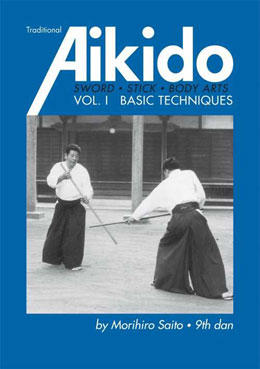BASIC TECHNIQUES (V1)
Sword - Stick - Body Arts

Front page
Contents
Traditional Aikido volume 1 covers:
- Introduction
- Riai - The combined Aikido System
- Ken Suburi
- No. 1 – 7
- Holding the sword
- Mental attitude of Partner Practice with swords
- Partner practice
- No. 1 – 7
- Kamae
- Entering method
- Irimi Techniques
- Shomen uchi Irimi Nage
- Shomen Uchi Irimi Nage – Sitting Technique
- Kokyu Nage – Tachi Dori
- Kokyu Nage – Tachi Dori (Tsuki)
- The Mental Attitude of Sword Taking
- Tai-no-henko
- Method of Body
- Method of Sword
- Sword and Body Relationship
- Shomen Uchi Shi-ho-nage Omote Waza (Method of the Sword)
- Shomen Uchi Shi-ho-nage Omote Waza (Method of the Body)
- Shomen Uchi Shi-ho-nage Ura Waza (Method of the Sword)
- Ryo te Tori Shi-ho-nage Omote Waza
- Shomen Uchi Kote Gaeshi (Method of the Sword)
- Shomen Uchi Kote Gaeshi (Method of the Body)
- Yokomen Uchi Shi-ho-nage (Method of the Sword)
- Yokomen Uchi Shi-ho-nage (Method of the Body)
- Kokyu-ho ( Standard)
- Kokyu-ho (sitting)
- Kokyu-ho (sitting)
- Basic Method of Aiki-jo
- The 31 count Kata
- The 20 Jo Suburi
- Thrusting movement (1 – 5)
- Striking movement (6 – 10)
- Wrist movement (11 – 13)
- Figure eight movement (14 – 18)
- Flowing Movement (19 – 20)
- Partner practise with Jo
- No. 1 (3 – 5 movement in 31 Jo Kata)
- No. 2 (1 – 3 movement in 31 Jo Kata)
- No. 3 (Tsuki Gedan Gaeshi)
- No. 4 (Menuchi Gedan Gaeshi)
- No. 5 (Sweeping down the partners Jo when attacked with thrust)
- No. 6 (10 – 11 movement in 31 Jo Kata)
- No. 7 (Sweeping the partners Jo when attacked with thrust
- No. 8 (When your Jo is swept down, flow with the movement)
- Glossary
-Introduction
The books in the Traditional Aikido series were written between 1973 - 75 by the late Morihiro Saito Shihan. They are among the most important documents ever written on Aikido and constitute a cultural treasure that commands a place in every aikidoka’s book collection.
Volumes 1 through 5 cover a wide range of techniques that form the basis of “Takemusu Aiki,” the spontaneous execution of unlimited techniques, the ultimate goal of the Founder’s aikido. These tomes also present the integrated system of taijutsu and the Aiki Ken and Aiki Jo as formulated in Iwama by O-Sensei following World War II.
The hardcover editions of Traditional Aikido have been out of print for many years and the publisher has endeavored to achieve and even exceed the same high quality as the original volumes of first editions from the 1970s. Volume 1 features the following:
- Hardcover with cotton cover
- High glossy paper
- Thread tied spine
- Dustcover
- 134 pages
- Includes over 600 illustrations
Traditional Aikido volume 1 is the first volume in a series of five and is the first book that Morihiro Saito wrote. Four years after the founder passed away, Saito Morihiro Shihan laid the foundation of his systematic approach to the art. The book contains the basic moves for training with sword, empty hands and staff, presenting Aikido as a combined system (Riai), or as Morihiro Saito Shihan’s writes in the foreword of Traditional Aikido volume 1:
This book intends to explain the fundamental relationships between the use of ken, jo and taijutsu. It was written with the consideration that it should be used for actual practice. For this reason, there are many photographs to be used for reference and understanding of the techniques. Some explanation about the form of the technique and necessary mental attitude has been used to augment the photographs.
A thorough understanding of basic techniques in use of ken, jo and taijutsu is necessary when dealing with many opponents. To stress this point, single movements of the basic Aikido exercises of tai-no-henko, and kokyu-dosa are explained. Therefore, the reader should pay particular attention to these basic exercises, since they are the basic of all Aikido movements.
Hundreds of technical photos illustrate the text, complemented by a number of historical photos of the founder and then the second Doshu Kisshomaru as well as shots of training scenes in Iwama.